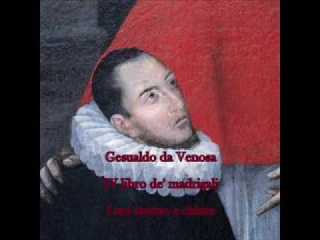Gesualdo da Venosa - Madrigali a 5 Voci Libro IV (2012)
Gesualdo da Venosa - Madrigali a 5 Voci Libro IV (2012)

[1] Luci serene e chiare [2] Tal'or sano desio [3] Io tacero, ma nel silenzio [4] Che fai meco, mio cor [5] Questa crudele e pia [6] Hor, che in gioia [7] Cor mio, deh, non piangete [8] Sparge la morte al mio Signor nel viso [9] Moro, e mentre sospiro [10] Mentre gira costei [11] A voi, mentre il mio core [12] Ecco, moriro dunque [13] Arde il mio cor [14] Se chiudete nel core [15] Il sol, qualhor piu (six voices) Quintetto Vocale Italiano: Karla Schlean soprano Clara Foti mezzo-soprano Elena Mazzoni contralto Rodolfo Farolfi tenor Gastone Sarti baritone Dmitri Nabokov bass Angelo Ephrikian – director
Prince Gesualdo's fourth book of madrigals for five voices was composed around the same time as the third book -- between 1594 - 1596, while he was at the court of Ferrara, having scandalous love affairs and hungrily absorbing the musical culture there. It is in these works that the "infamous" Gesualdo begins to emerge in his recognizable form. With a nagging ambition to be the first aristocrat considered a first-rate composer, he must have felt a terrible competitive pressure considering that the composers he was in constant contact with at the time were experimenting along the same harmonically adventurous lines. His later stylistic excesses stem more from that pressure than from the streak of violence in him that resulted in the overly-discussed murder of his wife.
Many new features emerge with force in Book 4. Double counterpoint, for example -- a mainstay of high Renaissance polyphonic technique that Gesualdo mastered and used to great effect in the first two books of madrigals -- here finds a new flexibility, pushing hard against its normal limits. It suggests the early stages of a new technical grammar. The major break with his earlier work, however, is in the harmonic and intervalic content: Diminished and augmented intervals, as well as odd sonorities and surprising, affective new harmonic rhythms become common currency in Book 4; the vocabulary of melodic intervals becomes so wide that no amateurs could even dream of performing the music anymore. Although madrigals are in essence a popular genre, often produced for amateur musicians' entertainment, Gesualdo is here writing for the élites of listeners and performers only.
What he is achieving most of all is a new intensity and freedom of melodic expression; the unusual harmonies are results of an expanded sense of contrapuntal movement, not its aim. Like nasty little ants crawling all over the pages, accidentals invade the music; every part of the polyphony becomes infested with expressive chromatic inflections. But the uses of these melodic movements are always tight and directed, and Gesualdo remains ever conscious of larger-scale tonality. No matter how far he strays into enharmonic danger zones, most of the madrigals begin and end convincingly in the same key. In fact one of the most characteristic new features is his specific uses of pedal points, a technique that seems to have developed as a means to eloquently handle complex resolutions to the home key from distant territory. Sometimes this entails aching suspensions that slowly transubstantiate into correct consonances; other times it involves beautiful figures such as two sustained outer parts framing parallel-moving inner parts. ---Donato Mancini, Rovi
download (mp3 @320 kbs):
uploaded yandex 4shared mega mediafire solidfiles zalivalka cloudmailru oboom








